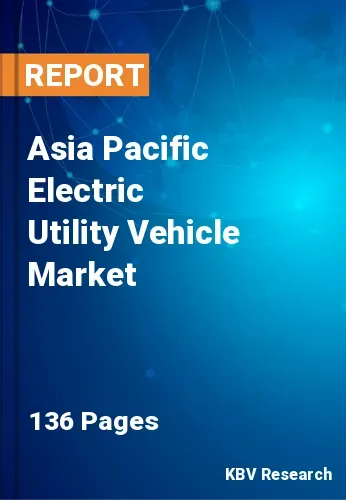The Asia Pacific Electric Utility Vehicle Market would witness market growth of 6.0% CAGR during the forecast period (2022-2028).
Throughout times when fossil fuels were scarce, a number of the earliest electric utility vehicles would play a significant role in the post-World War II industrial revolution in numerous countries and became mainstays for many businesses, municipalities, and private sectors. Rather than horsepower, an electric vehicle's motor output is measured in kilowatts (kW). If the motor installed in the utility vehicle is four kilowatts, it is equivalent to a five-horsepower gasoline-powered engine.
A key advantage of employing electric power in a low-speed vehicle, neighborhood electric vehicle (NEV), street-legal golf cart, parking shuttle, electric bus, or other electric utility vehicle is that the maximum torque of the electric motor may be provided across a considerably greater range of RPMs. The engine performance of an electric utility vehicle with a 4kW electric motor exceeds 5 horsepower. Due to the broader power band of modern electric motors, practically every type of electric utility vehicle may generate sufficient kW output.
The growth of the regional electric utility vehicle market is estimated to bolster in the coming years. This is due to the fact that Asian nations have potential GDP growth and a significant presence of automotive systems and component manufacturers. In addition, the increased demand for passenger automotive as well as commercial vehicles as a consequence of increasing disposable income has a direct effect on the expansion of the market in emerging Asian countries like China, Malaysia, India, and others.
The China market dominated the Asia Pacific Electric Utility Vehicle Market by Country in 2021, and would continue to be a dominant market till 2028; thereby, achieving a market value of $2,227.7 million by 2028.The Japan market is estimated to grow a CAGR of 5.3% during (2022 - 2028). Additionally, The India market would experience a CAGR of 6.9% during (2022 - 2028).
Based on Vehicle Type, the market is segmented into Industrial Electric Utility Vehicles, Electric Shuttle Carts, Electric Utility Carts, Electric UTVs and Electric ATVs. Based on Propulsion, the market is segmented into Pure Electric and Hybrid Electric. Based on Application, the market is segmented into Industrial, Commercial Transport, Recreation, Agriculture and Others. Based on Seating Capacity, the market is segmented 2-Seater, 1-Seater and Greater Than 2 Seater. Based on Battery Type, the market is segmented into Lithium-Ion, Lead Acid and Others. Based on Drive Type, the market is segmented into 2WD, 4WD and AWD. Based on countries, the market is segmented into China, Japan, India, South Korea, Singapore, Malaysia, and Rest of Asia Pacific.
Free Valuable Insights: The Worldwide Electric Utility Vehicle Market is Projected to reach USD 24.9 Billion by 2028, at a CAGR of 5.3%
The market research report covers the analysis of key stake holders of the market. Key companies profiled in the report include Textron, Inc., Polaris, Inc., Yamaha Motor Co., Ltd., Toyota Industries Corporation, BYD Company Ltd., Kion Group, Godrej Group (Godrej Material Handling), Columbia Vehicle Group Inc. (Nordic Group of Companies, Ltd.). Waev, Inc., and Addax Motors N.V.
By Vehicle Type
By Propulsion
By Application
By Seating Capacity
By Battery Type
By Drive Type
By Country

Our team of dedicated experts can provide you with attractive expansion opportunities for your business.

